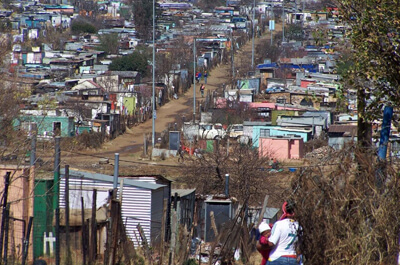
ANLI SERFONTEIN, in an article first published on the World Council of Churches’ website, reports that 40 years after the Soweto Uprising in South Africa, the expectations of many remain unmet…
Forty years after pupils in South Africa’s largest black township, Soweto, took to the streets to protest an inferior education system and set in motion the demise of apartheid, the release of Nelson Mandela and democracy, disillusion has replaced hope.
“Young people who fought fearlessly during this struggle had very high hopes for a better life when democracy was achieved but that expectation faded with time and many felt betrayed,“ the ELCSA Lutheran bishop of Soweto, Bishop Dr White Rakuba said last week.
 |
|
SOWETO TODAY: The township of Soweto in an image from 2009. PICTURE: Kevin James “Young people who fought fearlessly during this struggle had very high hopes for a better life when democracy was achieved but that expectation faded with time and many felt betrayed.”– Bishop Dr White Rakuba, ELCSA Lutheran bishop of Soweto |
On 16th June, 1976, tens of thousands of pupils in Soweto heeded the call to march against the forced instruction of Afrikaans in black schools.
“This was not about Afrikaans – though certainly that was the spark for the initial protests – but about the whole rotten system of Bantu education and the illegitimate government that imposed apartheid on society,” the rector of the University of the Free State, Jonathan Jansen, remembers.
It was intended as a well-organised protest march but met with the police opening fire on unarmed pupils. The iconic picture of the body of a lifeless 13-year-old Hector Pieterson, who died of police gunfire, became the symbol for a generation of protest.
One of the key leaders of the protest march, Murphy Morobe would 20 years later testify at South Africa’s Truth and Reconciliation Committee that they wanted to use the “Pied Piper of Hamelin” method, that is, going from school to school with more and more pupils joining.
In 1986, Morobe recalled that day when he smilingly said: “As I got dressed that morning I knew South Africa would never be the same again.”
International condemnation of the South African apartheid state was quick and unanimous. On 18th June, 1976, the UN Security Council unanimously condemned Pretoria for the police violence in Soweto and elsewhere.
The impact was felt in ripples. “This was the beginning of a fierce struggle for justice and change. The country never looked back. This brought the regime against the wall until it gave up,” Bishop Rakuba said.
“At the time of the uprising I was a theological student at the Marang Lutheran Seminary and you could imagine that, at that time, television in South Africa was just introduced and as theological students we had no TV and had to go to the lecturers to watch news of the burning of schools, the wild chase of the police and students, tear gas and the throwing of stones at police.”
South Africa introduced television in 1976, a brand new medium where censorship was still not in place, so those pictures were also carried into the houses of white South Africa.
Thousands were detained and by the time the protests had taken their course, 16 months later, more than a thousand people had died. Hundreds sustained gunshot injuries.
Many fled into exile, where the liberation movements were caught off guard by the new influx.
“The uprising in 1976 was not an ANC protest (it caught the comrades in exile off-guard) but one inspired by black consciousness organisations. This rebellion did not start and end in Soweto; it almost simultaneously saw youth uprisings elsewhere, from Atteridgeville to Athlone, during weeks of solidarity protests,” Dr Jansen wrote, remembering the uprising.
The apartheid government was also not prepared. Days after the unrest the government banned all mass meetings. Mass funerals were held despite the ban. The churches played a crucial role, stepping into the political vacuum. The Catholic Regina Mundi cathedral in Soweto became the yearly gathering place to commemorate 16th June.
Then Prime Minister John Vorster accused the then-Anglican first black Dean of Johannesburg, Desmond Tutu, of interfering in politics when he, a month before on 16th June, had written a letter warning him of black dissent by urging him to hold a National Convention open to all South African leaders to discuss making South Africa a more just society. Tutu ended the letter with a prayer: “Oh Lord, make us the instrument of your peace.” For the next 14 years, a church-state conflict raged.
The white minority government spent four times more on a white child’s education than it did on a black child. This disparity no longer exists, but the legacy remains and in recent years students have protested against the huge cost of their education.
Today, 16th June is a national holiday in South Africa, called Youth Day. However, Bishop Rakuba feels that, “the New South Africa left many young people destitute and June the 16th does not mean much anymore. Ask an average person, particularly those who were involved in the street battles with the police and they tell you how much they have been used.”
Educationist, Dr Jansen, sees it similarly. “I think we lost something in that noble struggle that we never recovered. We lost our attachment to education as a noble pursuit, as a vehicle for personal empowerment and social change.”
After struggling to transform the once whites-only conservative University of the Free State, and being attacked from all sides, he has resigned as of August 2016 to take up a teaching post in the US.
“It is important to remember those events well, especially with the continuing displays of imitative action by superficial young people who have no idea what the cost of courage in 1976 really was,” Dr Jansen said.
Anli Serfontein is a South African freelance journalist based in Berlin. This article was first published on the World Council of Churches’ website.






